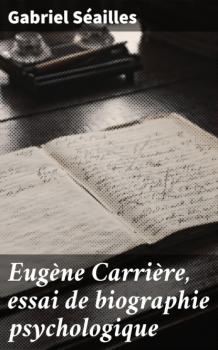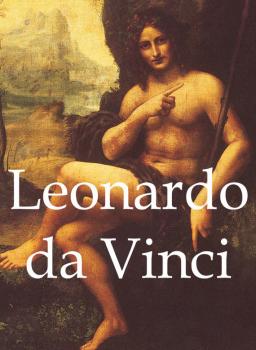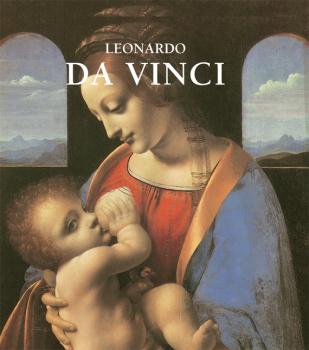Gabriel Seailles
Список книг автора Gabriel SeaillesEugène Carrière, essai de biographie psychologique
"Eugène Carrière, essai de biographie psychologique", de Gabriel Séailles. Publié par Good Press. Good Press publie un large éventail d'ouvrages, où sont inclus tous les genres littéraires. Les choix éditoriaux des éditions Good Press ne se limitent pas aux grands classiques, à la fiction et à la non-fiction littéraire. Ils englobent également les trésors, oubliés ou à découvrir, de la littérature mondiale. Nous publions les livres qu'il faut avoir lu. Chaque ouvrage publié par Good Press a été édité et mis en forme avec soin, afin d'optimiser le confort de lecture, sur liseuse ou tablette. Notre mission est d'élaborer des e-books faciles à utiliser, accessibles au plus grand nombre, dans un format numérique de qualité supérieure.
Leonardo da Vinci
Leonardo’s early life was spent in Florence, his maturity in Milan, and the last three years of his life in France. Leonardo’s teacher was Verrocchio. First he was a goldsmith, then a painter and sculptor: as a painter, representative of the very scientific school of draughtsmanship; more famous as a sculptor, being the creator of the Colleoni statue at Venice, Leonardo was a man of striking physical attractiveness, great charm of manner and conversation, and mental accomplishment. He was well grounded in the sciences and mathematics of the day, as well as a gifted musician. His skill in draughtsmanship was extraordinary; shown by his numerous drawings as well as by his comparatively few paintings. His skill of hand is at the service of most minute observation and analytical research into the character and structure of form. Leonardo is the first in date of the great men who had the desire to create in a picture a kind of mystic unity brought about by the fusion of matter and spirit. Now that the Primitives had concluded their experiments, ceaselessly pursued during two centuries, by the conquest of the methods of painting, he was able to pronounce the words which served as a password to all later artists worthy of the name: painting is a spiritual thing, cosa mentale. He completed Florentine draughtsmanship in applying to modelling by light and shade, a sharp subtlety which his predecessors had used only to give greater precision to their contours. This marvellous draughtsmanship, this modelling and chiaroscuro he used not solely to paint the exterior appearance of the body but, as no one before him had done, to cast over it a reflection of the mystery of the inner life. In the Mona Lisa and his other masterpieces he even used landscape not merely as a more or less picturesque decoration, but as a sort of echo of that interior life and an element of a perfect harmony. Relying on the still quite novel laws of perspective this doctor of scholastic wisdom, who was at the same time an initiator of modern thought, substituted for the discursive manner of the Primitives the principle of concentration which is the basis of classical art. The picture is no longer presented to us as an almost fortuitous aggregate of details and episodes. It is an organism in which all the elements, lines and colours, shadows and lights, compose a subtle tracery converging on a spiritual, a sensuous centre. It was not with the external significance of objects, but with their inward and spiritual significance, that Leonardo was occupied.
Leonardo da Vinci
Leonardo pasó los primeros años de su vida en Florencia, su madurez en Milán y los últimos tres años de su existencia en Francia. El maestro de Leonardo fue Verrocchio. Primero fue orfebre, luego pintor y escultor: como pintor, fue representante de la escuela científica del dibujo; más famoso como escultor con la estatua Colleoni en Venecia, Leonardo fue además un hombre de gran atractivo físico, encantador en sus modales y conversación y poseedor un intelecto superior. Era versado en las ciencias y las matemáticas de su época, además de ser un músico de grandes dotes. Su habilidad como dibujante era extraordinaria y puede verse en sus numerosos dibujos, así como en sus comparativamente escasas pinturas. Su habilidad manual estuvo al servicio de la más minuciosa observación e investigación analítica del carácter y la estructura de las formas. Leonardo fue el primero de los grandes hombres que tuvieron el deseo de captar en una pintura un cierto tipo de comunión mística creada por la fusión de la materia y el espíritu. Ya terminados los experimentos de los Primitivos, realizados de forma incesante durante dos siglos, y con el dominio de los métodos de pintura, fue capaz de pronunciar las palabras que sirvieron de contraseña a todos artistas posteriores dignos de tal nombre: la pintura es una cuestión espiritual, cosa mentale. Completó el dibujo florentino con el modelado por luz y sombras, un sutil recurso que sus predecesores sólo habían usado para dar una mayor precisión a sus contornos. Usó ese maravilloso talento en el dibujo, así como su manera de modelar la figura y el claroscuro, no sólo para pintar la apariencia exterior del cuerpo, sino para hacer algo que nunca se había logrado con tal maestría: plasmar en sus obras un reflejo del misterio de la vida interior. En la Mona Lisa y sus otras obras maestras llegó a utilizar el paisaje como algo más que una mera decoración pintoresca, convirtiéndolo en una especie de eco de esa vida interior y en un elemento de la armonía perfecta. A través de las todavía muy recientes leyes de la perspectiva, este docto erudito, que además fue un iniciador del pensamiento moderno, substituyó la manera discursiva de los Primitivos por el principio de concentración, que es la base del arte clásico. La pintura ya no se presenta al espectador como un conjunto casi fortuito de detalles y episodios. Se convierte en un organismo en el que todos los elementos, las líneas y colores, las sombras y la luz componen una trama sutil que converge en un centro a la vez sensual y espiritual. La preocupación de Leonardo no era la importancia externa de los objetos, sino su trascendencia interna y espiritual.
Leonard Da Vinci
“War Leonardos deutliche Berufung zur wissenschaftlichen Forschung eine Hilfe oder ein Hindernis für seine Arbeit als Künstler? Er wird gewöhnlich als ein Beispiel für die Möglichkeit eines Bündnisses von Kunst und Wissenschaft angeführt. In ihm, so heißt es zumeist, erhielt das schöpferische Genie durch die analytische Fähigkeit zusätzlichen Antrieb; der Verstand verstärkte die Vorstellungskraft und die Gefühle. […] Leonardo war ein tiefgründiger Gelehrter und unvergleichlicher Schöpfer und ist der einzige Mensch in unserer Geschichte, der in die geheimnisvollsten Verstecke der Wahrheit eingedrungen ist und gleichzeitig Visionen der strahlendsten Schönheit heraufbeschworen hat, der die Wissenschaft des Aristoteles mit der Kunst des Phidias verbunden hat." “Dadurch, dass er die Natur und alle für ihre vollkommene Wiedergabe wichtigen Wissenschaften – Anatomie, Perspektive, Physiognomie – leidenschaftlich studierte und klassische Modelle konsultierte, sich gleichzeitig allerdings die für ihn typische Unabhängigkeit bewahrte, konnte er bei der Kombination von Präzision mit Freiheit und von Wahrheit mit Schönheit nicht fehl gehen. Die raison d’être und der Ruhm des Meisters beruhen auf dieser endgültigen Emanzipation, dieser perfekten Meisterschaft der Modellierung, der Lichtgebung und des Ausdrucks, dieser Weite und Freiheit. Auch andere mögen neue Wege gebahnt haben, aber niemand reiste weiter oder stieg höher als er."
Leonardo Da Vinci
“War Leonardos deutliche Berufung zur wissenschaftlichen Forschung eine Hilfe oder ein Hindernis für seine Arbeit als Künstler? Er wird gewöhnlich als ein Beispiel für die Möglichkeit eines Bündnisses von Kunst und Wissenschaft angeführt. In ihm, so heißt es zumeist, erhielt das schöpferische Genie durch die analytische Fähigkeit zusätzlichen Antrieb; der Verstand verstärkte die Vorstellungskraft und die Gefühle. […] Leonardo war ein tiefgründiger Gelehrter und unvergleichlicher Schöpfer und ist der einzige Mensch in unserer Geschichte, der in die geheimnisvollsten Verstecke der Wahrheit eingedrungen ist und gleichzeitig Visionen der strahlendsten Schönheit heraufbeschworen hat, der die Wissenschaft des Aristoteles mit der Kunst des Phidias verbunden hat." “Dadurch, dass er die Natur und alle für ihre vollkommene Wiedergabe wichtigen Wissenschaften – Anatomie, Perspektive, Physiognomie – leidenschaftlich studierte und klassische Modelle konsultierte, sich gleichzeitig allerdings die für ihn typische Unabhängigkeit bewahrte, konnte er bei der Kombination von Präzision mit Freiheit und von Wahrheit mit Schönheit nicht fehl gehen. Die raison d’être und der Ruhm des Meisters beruhen auf dieser endgültigen Emanzipation, dieser perfekten Meisterschaft der Modellierung, der Lichtgebung und des Ausdrucks, dieser Weite und Freiheit. Auch andere mögen neue Wege gebahnt haben, aber niemand reiste weiter oder stieg höher als er."
Leonardo da Vinci
“War Leonardos deutliche Berufung zur wissenschaftlichen Forschung eine Hilfe oder ein Hindernis für seine Arbeit als Künstler? Er wird gewöhnlich als ein Beispiel für die Möglichkeit eines Bündnisses von Kunst und Wissenschaft angeführt. In ihm, so heißt es zumeist, erhielt das schöpferische Genie durch die analytische Fähigkeit zusätzlichen Antrieb; der Verstand verstärkte die Vorstellungskraft und die Gefühle. […] Leonardo war ein tiefgründiger Gelehrter und unvergleichlicher Schöpfer und ist der einzige Mensch in unserer Geschichte, der in die geheimnisvollsten Verstecke der Wahrheit eingedrungen ist und gleichzeitig Visionen der strahlendsten Schönheit heraufbeschworen hat, der die Wissenschaft des Aristoteles mit der Kunst des Phidias verbunden hat." “Dadurch, dass er die Natur und alle für ihre vollkommene Wiedergabe wichtigen Wissenschaften – Anatomie, Perspektive, Physiognomie – leidenschaftlich studierte und klassische Modelle konsultierte, sich gleichzeitig allerdings die für ihn typische Unabhängigkeit bewahrte, konnte er bei der Kombination von Präzision mit Freiheit und von Wahrheit mit Schönheit nicht fehl gehen. Die raison d’être und der Ruhm des Meisters beruhen auf dieser endgültigen Emanzipation, dieser perfekten Meisterschaft der Modellierung, der Lichtgebung und des Ausdrucks, dieser Weite und Freiheit. Auch andere mögen neue Wege gebahnt haben, aber niemand reiste weiter oder stieg höher als er."
Léonard de Vinci
Léonard de Vinci (Vinci, 1452 – Le Clos-Lucé, 1519) Léonard passa la première partie de sa vie à Florence, la seconde à Milan et ses trois dernières années en France. Le professeur de Léonard fut Verrocchio, d'abord orfèvre, puis peintre et sculpteur. En tant que peintre, Verrocchio était représentatif de la très scientifique école de dessin ; plus célèbre comme sculpteur, il créa la statue de Colleoni à Venise. Léonard de Vinci était un homme extrêmement attirant physiquement, doté de manières charmantes, d'agréable conversation et de grandes capacités intellectuelles. Il était très versé dans les sciences et les mathématiques, et possédait aussi un vrai talent de musicien. Sa maîtrise du dessin était extraordinaire, manifeste dans ses nombreux dessins, comme dans ses peintures relativement rares. L'adresse de ses mains était au service de la plus minutieuse observation, et de l'exploration analytique du caractère et de la structure de la forme. Léonard fut le premier des grands hommes à désirer créer dans un tableau une sorte d'unité mystique issue de la fusion entre la matière et l'esprit. Maintenant que les Primitifs avaient conclu leurs expériences, poursuivies sans relâche deux siècles durant, il pouvait prononcer les mots qui serviraient de sésame à tous les artistes du futur dignes de ce nom : peindre est un acte intellectuel, une cosa mentale. Il enrichit le dessin florentin en intensifiant la perspective de champ par un modelage de l'ombre et de la lumière que ses prédécesseurs n'avaient utilisé que pour donner une plus grande précision aux contours. Cette technique est appelée sfumato. Cette merveilleuse maîtrise du dessin, ce modelé et ce clair-obscur, il les utilisa non seulement pour peindre l'aspect extérieur du corps, mais aussi, comme personne avant lui, pour explorer une part du mystère de sa vie intérieure. Dans sa Mona Lisa, sa Sainte Anne et ses autres chefs-d'oeuvre, il ne se contente pas d'utiliser le paysage comme un ornement plus ou moins pittoresque, mais bien comme une sorte d'écho de cette vie intérieure, un élément constitutif de cette harmonie parfaite. Se fiant aux lois toujours assez récentes de la perspective, ce docteur en sagesse académique, qui, à cette même époque, posait les bases de la pensée moderne, substitua à la manière discursive des Primitifs le principe de concentration qui est le fondement de l'art classique. Le tableau ne nous est plus présenté comme un agrégat presque fortuit de détails et d'épisodes. C'est un organisme dont tous les éléments, lignes et couleurs, ombres et lumières, composent un subtil entrelacs convergeant vers un noyau spirituel, voire sensuel. Dans Mona Lisa, Léonard de Vinci dépeignit la quintessence de l'univers et de la femme, éternelle idée de l'homme et symbole de la beauté parfaite auquel il aspire. La nature est évoquée ici par un magicien dans tout son mystère et sa puissance. Derrière le charmant visage, calme, derrière le front, juvénile et pourtant méditatif, pparaissent des montagnes, des glaciers, de l'eau et des rochers. Dans cette très petite portion de surface peinte, se dévoile une vaste révélation, à côté de l'éternel féminin, de notre planète, notre mère la Terre. Léonard de Vinci ne se préoccupait pas de l'aspect extérieur des objets, mais bien de leur signification intérieure et spirituelle.
Leonardo Da Vinci
Leonardo’s early life was spent in Florence, his maturity in Milan, and the last three years of his life in France. Leonardo’s teacher was Verrocchio. First he was a goldsmith, then a painter and sculptor: as a painter, representative of the very scientific school of draughtsmanship; more famous as a sculptor, being the creator of the Colleoni statue at Venice, Leonardo was a man of striking physical attractiveness, great charm of manner and conversation, and mental accomplishment. He was well grounded in the sciences and mathematics of the day, as well as a gifted musician. His skill in draughtsmanship was extraordinary; shown by his numerous drawings as well as by his comparatively few paintings. His skill of hand is at the service of most minute observation and analytical research into the character and structure of form. Leonardo is the first in date of the great men who had the desire to create in a picture a kind of mystic unity brought about by the fusion of matter and spirit. Now that the Primitives had concluded their experiments, ceaselessly pursued during two centuries, by the conquest of the methods of painting, he was able to pronounce the words which served as a password to all later artists worthy of the name: painting is a spiritual thing, cosa mentale. He completed Florentine draughtsmanship in applying to modelling by light and shade, a sharp subtlety which his predecessors had used only to give greater precision to their contours. This marvellous draughtsmanship, this modelling and chiaroscuro he used not solely to paint the exterior appearance of the body but, as no one before him had done, to cast over it a reflection of the mystery of the inner life. In the Mona Lisa and his other masterpieces he even used landscape not merely as a more or less picturesque decoration, but as a sort of echo of that interior life and an element of a perfect harmony. Relying on the still quite novel laws of perspective this doctor of scholastic wisdom, who was at the same time an initiator of modern thought, substituted for the discursive manner of the Primitives the principle of concentration which is the basis of classical art. The picture is no longer presented to us as an almost fortuitous aggregate of details and episodes. It is an organism in which all the elements, lines and colours, shadows and lights, compose a subtle tracery converging on a spiritual, a sensuous centre. It was not with the external significance of objects, but with their inward and spiritual significance, that Leonardo was occupied.







